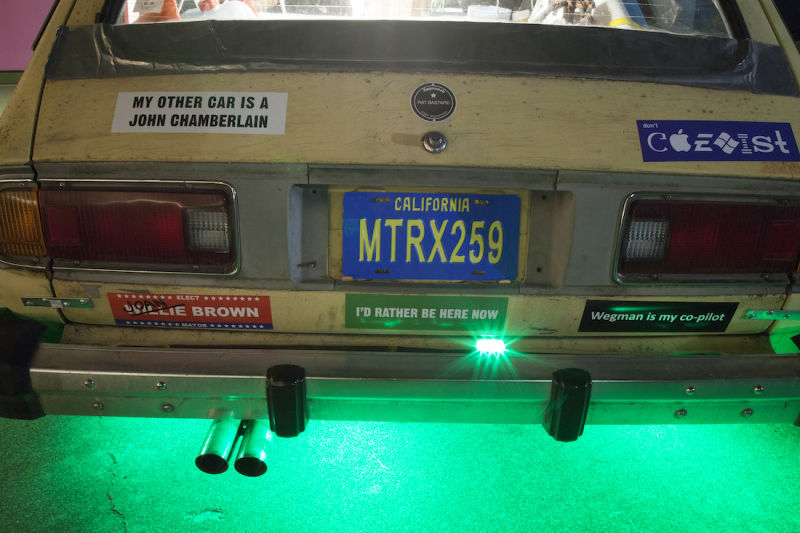At the UC Berkeley Art Museum and Pacific Film Archive, Will Brown / MATRIX 259 reactivates and expands on the history of a light installation by renowned minimalist artist Dan Flavin. The 1977–78 piece, untitled (for Gretchen, a colorful and fond match) sets in motion a host of new narratives linked to the transitioning museum and the Bay Area art scene’s ever changing character.
The show consists of several parts: a car full of ephemera which appears to have been abandoned in front of the now-closed Bancroft Way museum entrance; a light installation on the museum’s roof; an artist book on view at UC Berkeley’s Morrison Library; and New Light on Riboflavin, a play written by the poet Kevin Killian and performed on June 12, the night of the opening. I asked David Kasprzak, Jordan Stein and Lindsey White, the collaborators who make up Will Brown, to discuss this exhibition and their practice.
Your projects extend authorship to numerous individuals, many of whom aren’t involved in the initial conception or planning, but end up playing key roles in shaping content.
The question of authorship is something that was part of the Will Brown conversation from day one, or really even before day one. By calling our project Will Brown — creating a sort of fictional entity that could be anyone — the three of us were free to operate under a certain amount of anonymity and, more importantly, as a unified practice.
Our core interest lies in historical narratives, which always involve major and minor characters. In the case of this particular Dan Flavin history, the story of the BAM/PFA light installation wouldn’t exist without Gretchen Glicksman, the museum’s registrar, Barney Bailey, the museum’s chief preparator, and many others. In this way, Will Brown is as interested in people themselves as in the work they do.
Our projects wouldn’t happen without a lot of players, and we get to learn so much from them in the process of realizing an installation or program. It’s possible to look at Will Brown as a mini-institution in that it takes a lot of individuals playing different roles to execute something. The key difference is that we aim to collaborate with people in a more open, equal and malleable way.
What do you attribute this tendency in your practice to?
The three of us all came up in proactive, DIY, semi-marginal communities, which had a major impact on how we think about art and society. Nothing got done unless we did it ourselves, and “ourselves” was always people working together. The Bay Area is filled with so many smart, funny, interesting, unique individuals that it only makes sense for us to work with as many of them as possible. Given the current cultural and financial climate here, we imagine this type of collaboration is only going to become more crucial.

Can you reflect on the process of choosing and arranging the ephemera in the car and in the artist book?
The book is an archive related to Dan Flavin and his exhibition at BAM/PFA (then the University Museum) in 1978 and our own research, correspondence and other material concerning our MATRIX show. It’s a mirror, or a boomerang, between the past and the present.
The car is a less formal sculptural archive of the MATRIX program and of BAM/PFA itself. The materials inside are a mixture of actual ephemera from the MATRIX archive, objects, books and posters from the museum store, items given to us by other Bay Area artists who worked with BAM/PFA at some point and material we fabricated ourselves. The fun is trying to figure out what’s “real” and what’s “fake.”
We spent a good week moving things around the car and constructing the tableaux. We wanted it to feel like someone had been living in there. After that week of working in there non-stop, we didn’t really have to pretend anymore.
New Light on Riboflavin was performed on the opening night at the original museum’s entrance. What are your thoughts on the experience of being in the audience of this theatrical production on June 12 versus viewing the exhibition on any other day?
We commissioned Kevin Killian to write a play about anything he wanted, but requested that it include Dan Flavin, a green glow and a comment about the current state of the Bay Area art scene. New Light on Riboflavin is an important component of the exhibition, but it’s one of five parts. This exhibition activates history through several different experiences.
The opening was an excellent event with people flooding the exterior of the now-closed museum to catch a glimpse of the play. Kevin is a genius of tying together history, pop culture and the artist’s struggle in crude and hilarious ways. Those in the audience who stuck around past 9pm saw the green glow emanating from underneath the car and from the roof of the museum, along with a little fog set on a timer.
Each element of the exhibition is a little slippery and very theatrical, similar to how people recount historical events. You may pass the museum during the day and not even see the green glow. You may walk up to the car, look through the windows and think it’s just a bunch of junk. At night, the museum entrance looks completely different, as if an alien life force has taken over. You may stumble upon the artist book in the Morrison Library and wonder why some lunatic is obsessed with Dan Flavin. There are many versions of the story. Each person will have a different experience of seeing it, and that excites us.